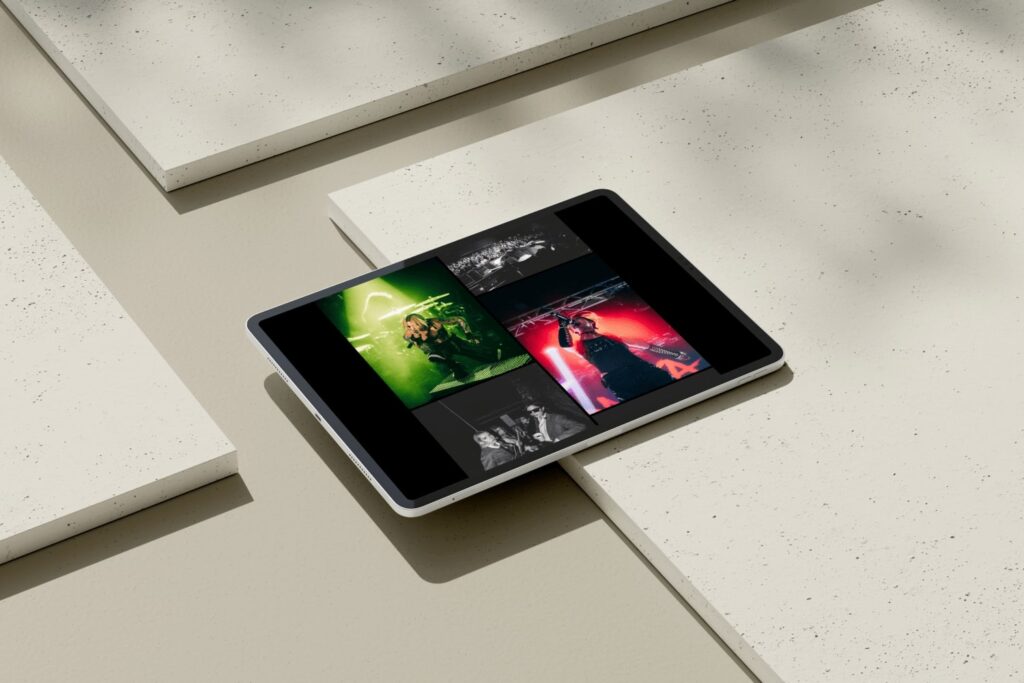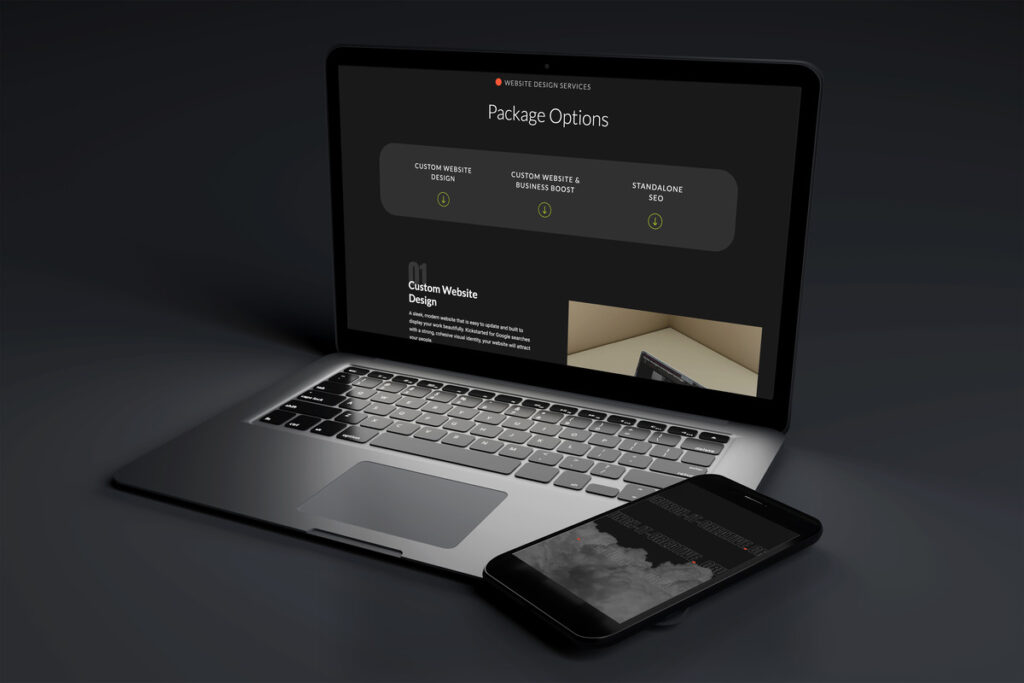Mastering Web Design for Photographers – Your Complete Guide
Let’s chat about mastering web design for photographers. As a web designer for photographers and a qualified SEO specialist, I know how competitive the online world is for you right now. If you want to make a positive impact, it’s time to up your online game so your audience can find you, increase traffic to your website, and book more clients!
A website isn’t just another place to showcase your best pictures; it’s where you should be making sales. If you’re not quite there yet or want to boost your bookings, this is the guide for you!
Photographers often struggle to get noticed in search engine results like Google and Bing, despite having a ‘f’ ton of great photos, awesome portfolios and exceptional talent. Why? Competition is fierce, as you well know. To stand out you have to do more than just ‘have a website’.
A website that’s optimised for search engines (SEO) and designed effectively and strategically can boost your online visibility and client engagement, setting your work apart.
In this blog, I will give you all the information you need to master the web design side of your online presence. It can get a ‘bit jagony’ but I will do my utmost to keep everything as straightforward as I can. If you ever need any help, please feel free to drop me a message here.
So if you want your business to perform online, you need to master web design to begin with. Ready to dive in? Let’s go!

Introduction to Web Design for Photographers
The Importance of a Professional Website
First impressions count! Yes, it’s a cliche, but we still keep saying it for a reason…it’s true. 94% of first impressions are design-related according to Hostinger and just to make that hit home further, 75% of visitors find well-designed websites more trustworthy, which makes them more likely to engage with your brand and book your services.
Therefore, if you want success online, a professional website is critical. A professional website takes into consideration your brand consistency, strategy and SEO to drive traffic to your website, as well as ease of use and up-to-date trends. A cluttered, outdated site can deter potential clients, costing you business.
With a strong professional online presence, you can really enhance your niche, impress potential clients, and showcase your awesome pictures effectively.
Key Elements of Effective Web Design
If you want to build your own website from scratch or considering a templated design then you should know there are some key elements for effective (and not just pretty) website design.
As we spoke about, first impressions matter and you know yourself how quickly you can ‘x out’ of a website if you find it tricky to navigate, too slow to load or it just doesn’t draw you in. To be effective your website needs to engage your clients and make your pictures the stars of the show, use minimalist layouts to enhance the visual appeal in your portfolio and ensure responsive design, meaning your work can be seen on laptops, mobiles and tablets without comprising your work.
Navigation is also important to ease any frustrations your clients may have when finding what they need. Read more about this next.
User-Friendly Navigation
We’ve all been on those websites where you just can’t find what you want, get frustrated, and give up, opting to find another page from the search results. You definitely don’t want your website to be that site! Thankfully, creating user-friendly navigation is pretty straightforward.
Menus need to be concise, clear, easy to understand and strategically positioned to enhance your client experience. It should feel natural, with each section flowing seamlessly into the next, making the user experience memorable and enjoyable.
If your website is well designed, this can make an impression, encouraging return visits and clients to spend more time exploring and appreciating your work. It’s this investment here that increases the website’s usability, which encourages a better connection with your potential clients and ultimately increases your chances of driving more business your way.
Mobile Responsiveness
It’s pretty rare now if a website isn’t optimised for a mobile phone or tablet, but some still aren’t and some need to be seriously evaluated. Mobile responsiveness is not an option, it is an absolute necessity. Google has a ‘mobile first’ attitude and more than half of all website visits are now made via your mobile phone.
You need to have a good and honest look at your website to see if it is effective on multiple screen sizes. Responsive design ensures that all visual elements, such as images and text, remain clear and accessible, providing a professional look regardless of the device. This is even more crucial for photographers whose portfolios need to look first-class on all platforms.
It’s obvious that if your website isn’t mobile-friendly, you could lose potential clients. People searching for photographers on their phones won’t invest in your services if your images look poor or shoddy on their screens.
By prioritising this, you can actually enhance the accessibility of your website and show your work in the best way possible. So it’s not just a design choice it’s a strategic decision to increase client satisfaction, gain higher web traffic and ultimately more cash in your back pocket!

High-Quality Visuals
As a photographer, in the realm of web design (and SEO), this is obviously paramount. But again, it’s not just about how your photos look, it’s the technical ‘backroom’ work that needs to be taken into account as well. For example, considerations should be:
- Utilising High-Resolution Images: Ensuring that images are sharp and detailed.
- Using a consistent Theme: Maintain a cohesive look through colour schemes and styles.
- Optimisation for Web: Balance quality with file size to ensure fast loading times and SEO optimise these (more on this later!).
- Showcasing Your Best Work: Highlight top portfolio pieces prominently and not just upload all your pictures for someone to trawl through.
Photographers need to balance all this with displaying high-res images that engage and draw your clients in. All this is a fine balancing act between the best of your photos and a seamless user/client experience.
Custom Web Design for Photographers
If you want to stand out in the highly competitive photography market, filled with templated designs, a custom website design is the way to go.
As a web designer for photographers and creatives, I have seen the difference a custom website design can make. When a website is tailored to your needs, reflecting your individual vibe, your portfolio can rise above the noise and have a standout presence.
When you invest in custom web design, you can showcase your work without limitations, keeping you ahead of commercial trends. Customised designs offer extensive creative control, support, and flexibility. They meet the evolving standards of web aesthetics. Plus, professional designers handle all the background work you don’t have time to learn.
Investing in custom web design ultimately empowers you to create a more compelling digital presence out there in the world. If you want to read more about why this is critical. Check out my blog post on professional custom website design here.

Choosing the Right Photography Platform
If you decide that you aren’t ready for custom website design or want to give it a whirl yourself then great! It’s important to know that selecting the ideal platform is key for your online strategy.
Weighing up your options as a photographer wisely could be the difference between doing well online or having a website that just flops.
With so many website platforms out there, each with its own set of advantages, tailored to different needs and preferences it can be difficult to know which to choose. Popular choices include WordPress, Squarespace, and Wix, each offering benefits like customisability, ease of use, and good customer support and are big market leaders that almost ensure longevity in the platform.
A good understanding of the specific requirements and long-term goals for your website is vital. This is to ensure the chosen platform aligns with your vision and strategy and will get you to your goals of achieving more leads and generating more clients. It’s the foundation of amazing design, search optimisation and functionality that will make all the difference.
But what about your budgetary restrictions? Read on to the next section if your budget is on the tight side.
Affordable Website Builders for Photographers
Finding the right balance between functionality and cost is essential for photographers. It’s important to choose a website builder that fits your budget while efficiently serving your needs.
I won’t go into too much detail here but it’s safe to say there are a lot of affordable options out there. Some are great to start you off, so you can get a handle on your business and what the online world entails. This gives you the freedom to focus on your craft without worrying about high costs. Wix and Weebly are great and user-friendly, but it’s important to balance this with creative freedom, the ability to optimise templates for search engines, and functionality, which may be lacking here.
I have had personal experience with some of the website builders out there and the next section explains some of the best.
Best Website Creators for Photographers
If you are up for a self-build or templated website, and let’s face it, there are a lot of easy to use options out there, then selecting the right platform to showcase your style of photography is important. It’s crucial to remember that a great portfolio website for photographers isn’t just about the way it looks. It should also offer excellent functionality and be easy for both you and your clients to use and update.
There are soooo many platforms out there and also photography specific ones too. Popular choices are Showit (my preferred platform), Squarespace, Wix and WordPress.
My advice would be to decide what you need out of your website, is it an e-commerce store, a place for blogging or showcasing your imagery in the best way possible, or all these things? Do you want more artistic control to stand out or just need a place where people can get hold of you and learn about your services? All of these platforms can offer something completely different with different functionalities, so list what you need to see if they tick all the boxes.
Don’t forget that once your website is built, it’ll need regular updates and maintenance. As a web designer for photographers, I get how hectic your schedule can be with busy weekends and endless editing. Keeping your website up-to-date is crucial for it to perform well. And that’s even before we dive into the world of search engine optimisation (SEO), so bear this in mind when choosing the platform.
With the easy-to-use ‘drag and drop’ editors, like Squarespace and Wix updating your website can be easy but with powerhouses like WordPress, functionality and SEO are far superior but you need to invest a lot of time learning how to use it correctly. Choosing the right platform needs an honest discussion with yourself about how much time you have to invest in it.
If you need more information about the best website for photographers, check out my blog on Top 7 Best Websites for Wedding Photographers & Pro Tips!

Customising Website Templates
Another great option for when you are starting out is customising a website template. This allows you to have a tried and tested design framework to use for your style, such as colours and fonts. These layout options are readily adjustable, enabling you to match the website to your brand.
Once you have chosen an ideal template, you can begin the customisation process. Integrating functional elements like contact forms and social media links can enhance user interaction and engagement. The use of custom plugins or widgets can further personalise the site, allowing you to showcase your portfolio.
It is worth noting that using templates for website design and SEO in photography can have some downsides. Templates when not customised correctly can often lead to generic-looking websites that fail to stand out in a competitive market.
There can also be a limit on the customisation options available, making it challenging to tailor your site to your specific needs and brand identity. Additionally, templates may not be optimised for SEO, potentially hindering your website’s search engine rankings and reducing visibility to potential clients. So all this needs to be balanced.
So now you have a bit of an insight about the actual website builders, what pages should your website have? Take a look next!
Essential Pages for Photographer Websites
A portfolio page is obviously important to photographers, but what about the other pages? As a web designer for photographers, I recommend the following pages as a minimum for your website. They not only help with client engagement but also with optimising your website for search engines. These are a homepage, portfolio page, about page and contact page.
A portfolio page, showcasing your best work, serves as the cornerstone of any photographer’s website. Designing a great ‘About’ page allows visitors to connect with your story, style, and vibe. This connection can help with client trust and engagement. The use of a well-designed ‘Contact’ page means more potential clients’ queries, enquiries and collaborations.
So let’s take a look at the key things each of these pages should contain.
Homepage
The homepage serves as the digital first impression for potential clients, making it super important to your killer website. It should contain the following
- Hero Image or Video: A powerful, high-quality visual that encapsulates your style from the get-go!
- Clear Navigation: Simple and easy-to-use menus that lead visitors through your site easily.
- Call-to-Actions (CTAs): Strategically placed CTAs guiding visitors to the places you want them to go, such as portfolios, contact forms, or booking pages.
- Introduction Section: A brief yet intriguing introduction about you the photographer, highlighting any achievements or interesting things it would be great for your potential client to know about. You can also have a little fun here, if that’s the way you roll as a photographer.
- Client Testimonials: Feedback to build your credibility and trust with potential clients.
To be effective on a homepage you must engage visitors straight away for them to stay on your site and explore other pages. This design must look professional and really make your individuality and brand shine through and above other photographers out there. When done correctly visitors are sure to come back for more and potentially turn into clients.
Portfolio
Now the big guns, your photography portfolio. Firstly I should say that you don’t need to put all of your pictures on your portfolio page, it can be quite overwhelming for clients to trawl through reams of images, get lost on the page and be unable to find their way back to contact you. This can be even worse on mobile designs where the screen size is a lot smaller. Let’s not give your clients a repetitive strain injury by scrolling through all your photos!
So let’s choose your best and favourite images and make it very easy to navigate in terms of all your areas of work. What I mean by this is strategically organising your portfolio pages to make it easier for visitors to your website. If you are a wedding photographer, for example, try organising them in terms of weddings, engagements & elopements. This means you can comprehensively cover what you do, save your prospective clients from scrolling for too long and giving up, and also make it easier for them to find what they are looking for.
Ultimately, a well-designed portfolio goes beyond your impressive photos. It reflects your brand, professionalism, and attention to detail. Presenting your work in the best light possible means you can leave a lasting impression, encouraging potential clients to take the next step towards working with you.
Contact Page
A well-designed contact page is often overlooked and underestimated but photographers need to convert visitors into clients. Your contact page should have the following:
- Clear Contact Form: Include fields for name, email, phone number, and message.
- Professional Email Address: Use a dedicated, professional email for enquiries and not youroldschoolone@hotmail.com
- Phone Number: Make sure the phone number is prominently displayed.
- Physical Address: If applicable, add the studio’s physical location.
- Social Media Links: Provide links to professional social media profiles.
- Availability: Mention availability or working hours.
Ensure the contact form is user-friendly so there are no blockers to contacting you. Providing multiple ways to get in touch also builds trust and accessibility with potential clients.

E-Commerce Website Solutions for Photographers
Some photographers need easy-to-use e-commerce solutions to sell their art effectively. Platforms like Squarespace offer built-in e-commerce functions, simplifying the selling process. Additionally, WordPress combined with WooCommerce or Showit with Shopify allows photographers to create customised online stores with total control over their digital storefronts and sales channels.
Setting Up an Online Store
Creating an online store is awesome for selling prints and merch and depending on your platform choice, it can be relatively straightforward, albeit, quite time-consuming to set up. Pick a platform that makes transactions smooth and the user experience top-notch. Use high-quality images, engaging descriptions, and easy navigation to make your store stand out. Don’t forget to nail those keywords, meta descriptions, and alt tags to boost your SEO and drive more traffic to your site (a simple glossary will be dropping soon, I promise!) Make it fun if that’s your vibe but always visually appealing to keep your customers coming back for more!
Setting Up Easy Payment Options
Integrating easy payment options streamlines the purchasing process for clients, enhancing their overall experience. Here are a few pointers –
- Security: Ensure robust encryption for secure transactions.
- Diversity: Offer multiple payment options such as credit cards, PayPal, and Apple Pay.
- Compatibility: Make sure the integration actually works on your platform of choice.
- User Interface: Make it an easy and intuitive checkout process.
- Compliance: Adhere to legal and regulatory payment standards.
Don’t forget, although some platforms don’t charge you for purchases, it’s often the payment companies like Paypal etc that do.
Website Performance and Security
Speed Optimisation for Photography Websites
Having a website that loads fast is super important for photographers. Your photos and videos are your calling card and instant connection with potential clients. Google prioritises website loading speed as a ranking factor. This means that if your website loads slowly, it is considered to be performing poorly. As a result, it may not appear in search results.
To optimise your images for loading speed, consider using image compression tools without compromising quality. Pay attention to image file size and type. For more detailed information, check out my blog on search engine optimisation.
Using a content delivery network (CDN) can greatly improve your website’s speed and performance by hosting copies of your site’s files on servers worldwide, which is especially helpful for international visitors. Some website builders have poor loading times, so be sure to check reviews when researching your platform.A fast website not only improves user experience but also enhances search engine rankings, attracting more potential clients.
Website Security for Photographers
Website security is essential for photographers, well for anybody owning a website, to be honest. But you need to protect your portfolio with strong, unique passwords. As well as this, it’s good to add an extra layer of security with two-factor authentication (2FA). Keep your website software, themes, and plugins up to date to minimise vulnerabilities.
Most websites come with SSL certificate encrypts (that little lock you see on the left side of the search bar) and a warning comes up without one. This is a no-brainer, it would put clients off visiting your website and put Google off showing it in the search results without one.
Website Content Strategies
I wouldn’t be doing my job right as a web designer and SEO expert if I didn’t mention blogging. Blogging is vital for photographers, read on to find out why!
Blogging for Photographers
Writing a blog post isn’t just about your weekly musings or reporting on a recent wedding couple you photographed. While this is lovely if you enjoy it, you are missing out on its real purpose.
Blogging is all about driving potential clients to your website. No one is Googling ‘Jenny and Clare’s engagement in the Cotswolds’, but they are Googling, ‘best places in the UK for an engagement photoshoot’.
As a blog writer for photographers, I have seen firsthand how targeted blogging can increase visitors to your website. It’s about keyword research and writing informative and original content around those search phrases.
Incorporating a wide range of content types such as tutorials, behind-the-scenes shoots, and client testimonials, will keep the blog engaging. Establishing yourself as an expert in your photography niche can attract a broader audience and connect with your clients.
It’s not just about the photos in your post either. Use them strategically to showcase your skills and guide readers towards your photography services. Place your best shots in key areas to highlight your talent and subtly steer visitors to consider hiring you. Speaking of which, we are nearly at the end of this blog! Read on for my final thoughts.

Final Thoughts on Mastering Web Design for Photographers
I have covered a lot of ground here to master website design as a photographer. It’s not easy, it can be very time-consuming, with lots of intricacies that you may or may not know about. SEO is critical for photographers too, and I won’t design and build any website that isn’t optimised for search engines. If you want to read more on that topic then click here.
Building your own website can be very rewarding. There are many easy-to-use and great templates available. However, ask yourself this: if you had multiple photography websites open in different tabs, how would yours stand out from the crowd? Be that point of difference!
If you are interested in a killer custom website that actually performs, I would love to chat! I like to take the project off your hands and build you a website that attracts your people. You can click here to see my website services or here to get in touch.
If you are interested in reading more then check out these posts –
Drop me a comment